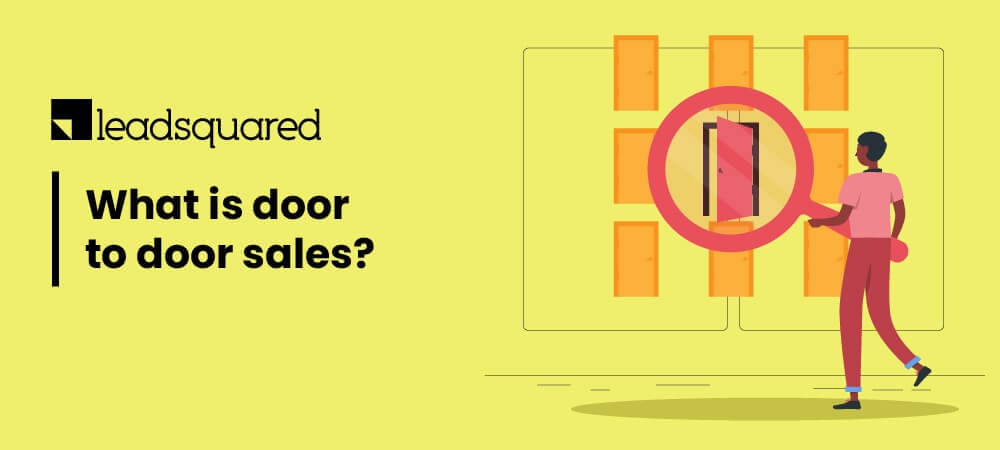Door-to-door sales are one of the oldest forms of selling. At one time, it used to be the main way to sell your products by approaching people directly. However, with the advancement of telecommunication and the internet, this process of selling fell out of fashion. Some thought it would be dead!
Going against all the odds, door-to-door sales did not die! Instead, it started getting popular again with the start of the 21st century. Many industries, like telecommunication, depend on direct selling even today. Most B2B sales also follow the face-to-face approach to make more impact on commercial clients.
In this post, we will give a modern takedown on door-to-door sales and what it involves.
What is Door to Door Sales?
Door-to-door sale is a direct process of selling. Sales reps visit door to door in a target geographical area and try to convince the residents to buy their products or services.
A typical door-based selling involves the rep going to the doors of a potential customer. He greets and initiates a conversation with the homeowner and try to assess his needs. After that, he will try to align his product or services with the customer needs and show the benefits of using the product.
Ultimately, the salesperson will ask the homeowner to buy the product.
B2B sales also adopt a similar process. Here sales reps visit companies and try to land an appointment with senior executives and decision-makers. Then the same process of convincing will follow.
B2B sales will most probably also involve additional ways of persuasion, like presentations and demos.
Characteristics of Door to Door Sales
Personal Touch
Door to door selling involves meeting potential customers face-to-face. This creates a greater personal touch than approaching someone over phone or email. The sales reps can form a personal connection and reach an endless number of customers in this way.
You can also personalize your messages and cater to the specific needs or interests of the client.
The personal approach makes door-to-door selling more effective. 65% of field sales reps achieve their quota, while only 55% of inside reps do the same.
Demand Creation
A field sales rep visits doors of potential customers and generates demand. The customer may not be even aware of the product exists. As a result, door-to-door selling is more challenging than converting inbound leads.
Field Activities
Sales reps who sell door to door spend most of their time outside the office. They also have to travel around the city to visit customers and find new areas of targeting. Many companies rely on a field automation solution to coordinate and manage outside sales efficiently.
A Glimpse of Door-to-Door Sales Process
1. Prospecting
Outside sales rep don’t always rely on leads generated by the marketing team. They spend a considerable time finding potential customers to approach.
Naturally, prospecting is crucial for door-based selling to sell products and grow the customer base.
2. Qualifying Leads
Door-based salespersons don’t have the advantage of software to score or qualify leads. They have to do it manually!
A field sales rep will ask many open-ended questions to identify and create a need. Once the need is determined, the salesperson will try to assess the budget and buying authority of the prospect.
A customer who matches all requirements is a potential prospect.
3. Pitching Your Product
Next, the sales rep will pitch or explain the benefits of his product or service. He/she will try to align the benefits and features with the customer’s pain points for chances of conversion.
4. Closing the Deal
The final stage of door-to-door sales is asking the potential prospect to buy your product. You can adopt various strategies to close the deal based on what works best.
5. Remember to Follow-Up
Sales reps contact the customer after the sale to determine if he or she is satisfied with everything. Following-up helps raise customer satisfaction and create a loyal customer for more business.
Factors Affecting the Success of Door to Door Sales
Various factors can make an impact on your selling potential and results in door-based selling. Here are the most crucial ones to consider-
Communication Skills
An outside sales rep should have good communication skills to convince a customer. They should be able to strike conversations and explain the benefits of products in a clear and easy-to-understand way to the customer.
Product Expertise
Door-to-door sales reps need to be an expert on the product. They need to answer every question of the customer and provide value by explaining the features or benefits of the product.
Body Language
Direct ways of selling that involve face-to-face meeting is highly animate. Reps have to keep a watch and take cues from the facial expressions and body language of the prospective customer.
Understanding body language helps you make out what your prospect is feeling. As a result, you can adjust your tone or speech for maximum effect.
Sales Script
A fixed sales script is not useful for door-to-door selling as the conversation can change track anytime. However, sticking to a sales script helps you stay on track and don’t let you forget the things you should ask or say.
Stay flexible and use this door to door sales script as a checklist for the best results.
Patience
Being too pushy and making the pitch too early can result in lost sales. Patience is a really important trait for field sales reps, and they should always be patient with customers. If you feel the client needs more time to decide, just ask for a future appointment.
[Also read: Door-to-door sales app – features and benefits]
Wrapping Up
Door-to-door sales have picked up the pace once again and come back into relevance. Many companies are using the method to expand their reach in this age of “no-calling” laws and cold email marketing. To make the most of your door-to-door sales, consider empowering your reps with a mobile CRM to land more sales.







